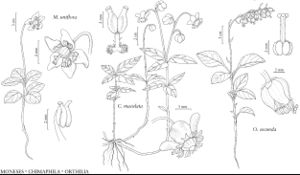Orthilia
Autik. Bot., 103. 1840 ,.
Herbs or subshrubs, chlorophyllous, autotrophic. Stems decumbent or erect, glabrous or papillose, especially distally. Leaves cauline, alternate or pseudoverticillate in (1–)2–4 whorls; petiole present; blade not maculate, ovate to broadly ovate or elliptic to orbiculate, subcoriaceous, margins entire or undulate to serrulate, rarely serrate, plane or, rarely, obscurely revolute, surfaces glabrous. Inflorescences racemes, often lax in bud or flower, usually erect in fruit, (secund); peduncular bracts usually present; inflorescence bracts free from pedicels. Pedicels recurved to reflexed in fruit; bracteoles absent. Flowers radially symmetric, spreading or nodding; sepals 5, connate proximally, often obscurely so, calyx lobes broadly triangular to ovate; petals 5, distinct, greenish white, yellowish white, or white, with 2 inconspicuous basal tubercles, corolla suburceolate; intrastaminal nectary disc absent; stamens 10, included or barely exserted; filaments broad proximally, gradually narrowed medially, slender distally, glabrous; anthers oblong, without awns, without tubules, dehiscent by 2 round to elliptic pores; pistil 5-carpellate; ovary imperfectly 5-locular; placentation intruded-parietal; style (exserted), straight or nearly so, expanded distally or not; stigma 5-ridged, without subtending ring of hairs. Fruits capsular, pendulous, dehiscence loculicidal, cobwebby tissue exposed by splitting valves at dehiscence. Seeds ca. 1000, fusiform, winged. x = 19.
Distribution
North America, Mexico, Central America (Guatemala), Eurasia, circumboreal.
Discussion
Species 1: North America, Mexico, Central America (Guatemala), Eurasia; circumboreal.
The basal tubercles on the petals of Orthilia are unique among Monotropoideae. On fresh or rehydrated flowers they are about 0.2–0.3 mm in diameter and 0.1–0.2 mm tall. The tubercles appear as obscure thickenings on dried specimens. H. F. Copeland (1947) found no evidence of glandular activity associated with these tubercles and speculated that they may influence the opening of the flowers, as do the lodicules of grasses.
Species 1
Selected References
None.
